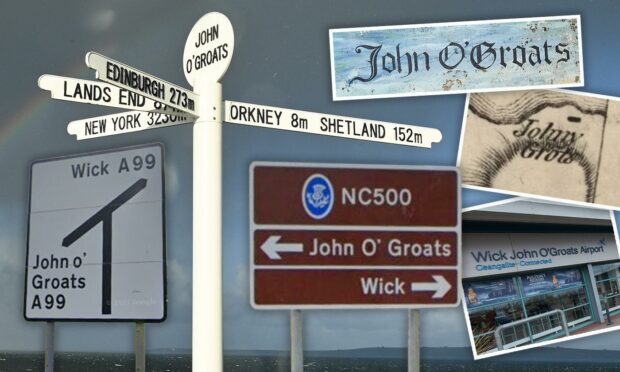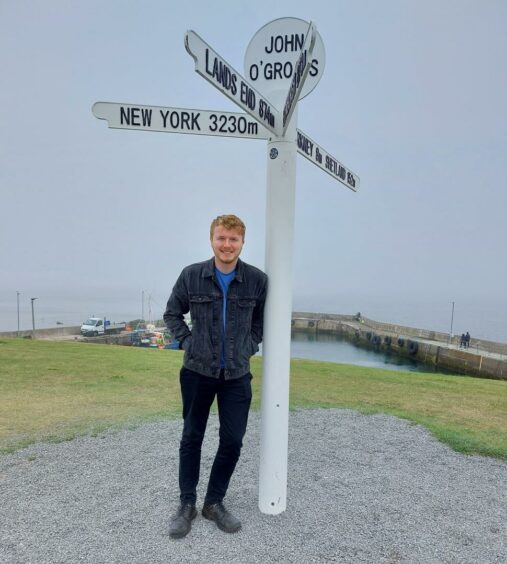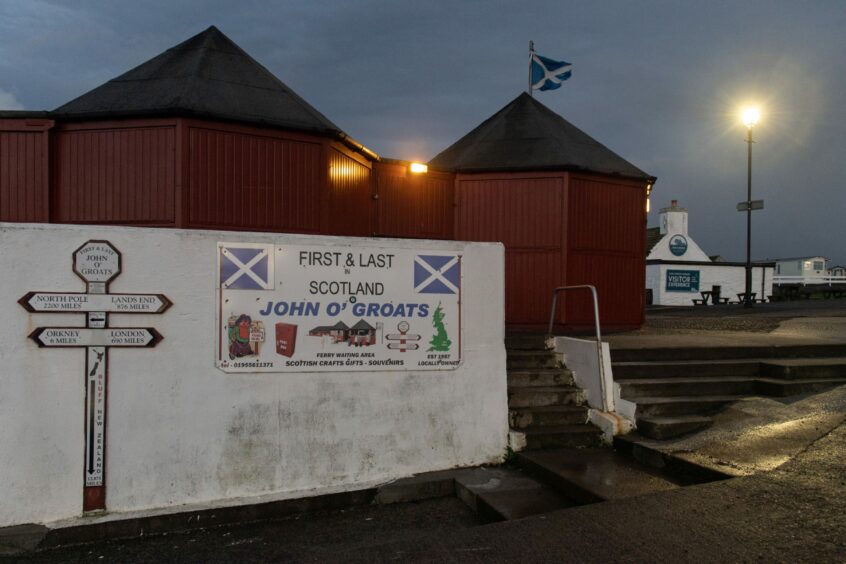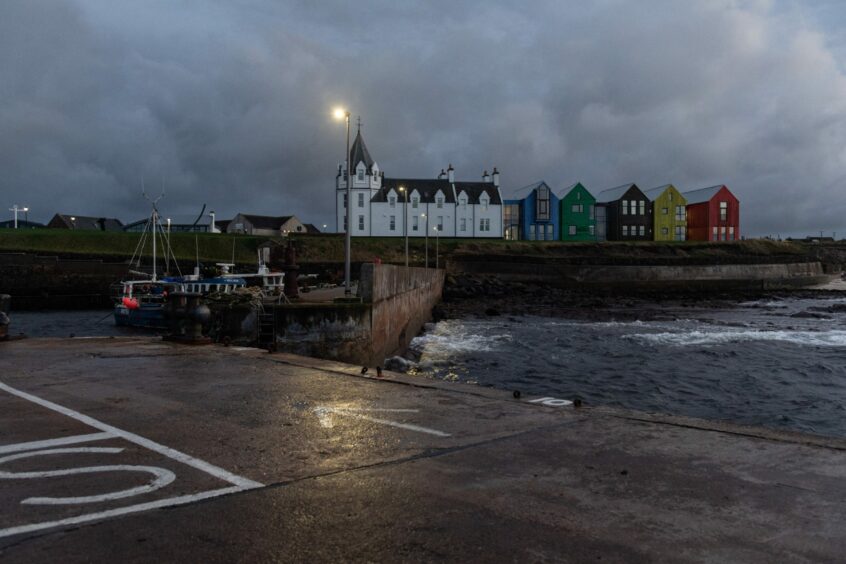It is one of the most famous addresses in the UK, the start or end point for the country’s longest journey, forever paired with Land’s End across the full length of Great Britain.
You’ve all heard of it, of course. But have you ever tried writing down its name?
This is something I first noticed earlier this year on a family holiday to Caithness, and if it’s something you had never noticed before – I apologise. But I promise that by the end of this article I’ll have provided you with what I think is a satisfying conclusion.
If you’re travelling east along the A836 in the Highlands – feel free to try this on Google Streetview – you’ll pass a road sign for the North Coast 500 pointing you towards John O’ Groats.
Barely 20 metres further along the road, you’ll pass another official sign showing you the turn-off for John o’ Groats.
If you take that turn-off, you’ll see yet another sign: this one is for the John O’Groats caravan park.
It gets worse. Take a look at this screenshot from Google Maps:
You can see it all there. Big O’s, small o’s, spaces before Groats and no spaces before Groats. And this is in the village itself.
It’s not a problem exclusive to this end of the country – it was only in 2018 that Cornwall Council voted to officially add an apostrophe to Land’s End (though as you can see in the picture below, there is still one missing from the Caithness signpost).
However, for the sheer number of alternatives and persistence of inconsistency, there can’t be many places in the country to rival the one we’re focusing on, and certainly not any that are as well-known.
A bit of context about me: before becoming a reporter, I worked as a sub-editor for the Evening Express and Press & Journal, fixing typos, inaccuracies and inconsistencies in other people’s stories.
So this kind of thing drives me nuts.
A couple of months ago, I decided to try to get to the bottom of this, to figure out for good how we should write the name of the north-easternmost settlement in Great Britain. Here is what I found out.
Part One
The first place I thought to look for an answer was in the history books – perhaps I could argue that the spelling that was used earliest is the correct one.
I got in touch with Caithness historian Alan McIvor who, in our first phone conversation, said a tantalising sentence that only served to make me more determined in my search: “I believe it’s something, Craig, that might be lost in the mists of time.”
Those mists have certainly obscured the story of the village’s namesake.
According to the place-name historian Dr Doreen Waugh, the Grot family first appeared in a charter dated 1496, and papers from the Mey family in 1564 refer to a John Grot who had been in possession of land on the island of Stroma in the Pentland Firth.
The legend goes that Dutch-born John (whose surname is also given as ‘de Groot’, meaning ‘the big’) ran the ferry over to Orkney, and after he and his brothers settled in Caithness, their families grew until there were eight quarrelsome relatives all with the surname Grot.
They could not decide who should get the honour of sitting at the head of their table, and so John constructed an octagonal house with a door in each of the eight walls, and placed an octagonal table at its centre. This bizarre arrangement apparently kept the family happy.
The house became famous around the country, and old maps show how it ended up lending John’s name to that of the settlement itself.
The Roy Military Survey of Scotland, completed between 1747 and 1752, refers to ‘Johny Grotts house’, while less than 30 years later, in George Taylor and Andrew Skinner’s survey maps from 1776, the name has become just Johny Grots:
By 1832, when John Thomson created his Atlas of Scotland, it had become John O. Groats House – the ‘O’ possibly coming from a misinterpretation of the –y ending of Johny.
The national mapping agency Ordnance Survey originally went with ‘John O’ Groats’, but at some point switched to ‘John o’ Groats’ and continues to use that form today. (Notwithstanding the official web page where you can buy the Caithness map, which uses John O’Groats.)
Overall, it was still a complete mess. It is a common cartographical rule that the further back you go, the less consistent spelling will be, as people a few hundred years ago would be more reliant on hearing the name said aloud than writing it out.
The issue is even greater for tiny places with unusual spellings, such as one named after a man whose story seems to be as much mythology as fact – and whose surname seems to be spelt differently in every source that tells that story.
I was not satisfied.
Part Two
My next idea was to reach out to people who should be in the know, and find out if there was any vague consensus there.
In my sub-editing days, I was bound to the P&J style guide, which explicitly calls for ‘John o’ Groats’ to be used. That doesn’t mean it is, though: according to one of the articles accompanying our environment team’s superb Cop26 road trip documentary earlier this year, they started in John O’Groats. (Kieran Beattie’s own article did stick with the style guide – good man.)
So what about other newspaper style guides? Not all of them mention the village, but The Guardian insists on what might be my least favourite form: ‘John o’Groats’, with a little o and no space.
The man who edited that style guide, David Marsh, told me he was continuing a precedent set by the 1969 edition, and that it avoided the clunkiness of o’ and Groats appearing on separate lines – fair enough for a newspaper, I thought.
But what about the people who live and work there? Surely they are the experts.
First of all, I contacted the councillors who represent the area. Jill Tilt, who was elected to represent the Wick and East Caithness ward in August of this year, told me she always used a little o when she wrote out the name.
Then, I found a list of businesses based in the village and started calling them up to see what they thought.
A woman called Annie, who lives locally and works at the First and Last Gift Shop beside the harbour, told me over the phone she always wrote it as John O’ Groats.
So far, every one of the alternate spellings had been floated by these people. This latest plan was already looking a little doomed.
A ray of hope did come, though, when I called up Simon Cottam, the director of a new brewery established in the village’s famous Last House.
He said: “We did think it was something we had to look into, because there seemed to be differing views and some strong views either way. So we canvassed a lot of local people as to what they thought was the correct spelling.
“The way we went for it was little o and an apostrophe with no space between the o and the G. O-apostrophe-G, all one.”
He added: “That’s what we’ve gone with so far, and we haven’t had any negative feedback on any of our documents or anything like that.”
A result! A result from no less than a survey of locals, and it’s the Guardian-style John o’Groats.
However – and I cannot stress enough how much this hurts to write – someone should tell Mr Cottam about his website, which alternates between John O’Groats and John O’ Groats.
Desperate for a revelation, I reached out to the village tourist information office, thinking they would surely be able to give me a definitive answer.
I got through to Shona Cormack, another local woman, and when I was barely one sentence into explaining what I was calling about she started laughing. This, clearly, was an argument she was very familiar with.
She told me she wrote it as John O’ Groats – at least, that’s always how she was taught. And as she said those words, I could almost hear something click inside her head.
“Actually,” she said, “I think I know someone who might be able to help you with this.”
Part Three
Christine Shearer called me back an hour or so after I left a message on her answering machine.
In an appropriately authoritative but gentle voice, she confirmed that 30 years ago she had become head teacher of Canisbay Primary – the catchment school for children growing up in the very north-east tip of Great Britain – and stayed in that position until 2005.
Before that, Mrs Shearer had been teaching at the school since 1977. She is likely the most prominent figure in the education of this small part of Scotland over the past 50 years: maths, reading and writing.
She told me: “It’s a proper name, so it would have a capital J, and a capital O apostrophe, and a capital G.
“I was always taught that names of people, places, countries and whatnot were proper nouns so they all needed capitals.”
She added: “Personally, I would like to see capital letters at J and O and G, but that’s probably because I’m old-fashioned.
“You’d have the John, space, capital O, apostrophe, space, Groat. Because if you were writing it out properly, if it was John of Groats, you would have a space between all your words.”
Will this put the matter to bed once and for all? Perhaps not. These inconsistencies are baked into web pages, books, road signs and maps, and it would take a lot to reverse the damage. They’ll continue to make me wince every time I spot them.
But an individual teacher can have a profound impact on a community – and Mrs Shearer more than most. I am quite happy to accept the authority of the woman who taught two generations of children that the place in which they grew up is named John O’ Groats.













